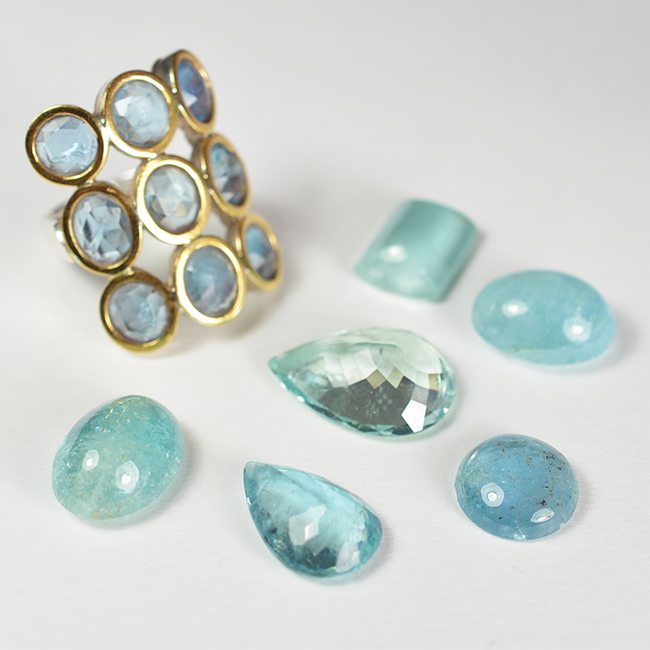Ethics of Producing Coloured Gemstone Jewellery
The millennial world we live in is more concerned than ever about the traceability of its products. A trend that has its roots in food supply, has moved on to cosmetics, clothes and even jewellery. As a responsible society understanding the background of the items we buy, from the conditions affecting local workers to environmental impact is key to feeling comfortable and connected with our favourite brands.
Here at Sushilla a strong ethical code is at the very centre of our business and for our jewellery to be truly beautiful we understand that it must be created and sourced with care and consideration. Although many of the poor practices surrounding diamond mining have been widely explored and publicised the world of coloured gems has been less closely scrutinised. This is perhaps because of its connection with artisanal, small scale mines often in remote locations. Today we will look a little more closely at the ethical issues affecting coloured gems and the steps we take as a company to craft socially responsible jewellery.
Mining and Working Conditions
Mining of any substance can be dangerous, labour intensive and requires careful management to ensure that people working in this environment are kept safe and healthy. The mining of gems is no exception and unfortunately around the world we find examples of poor and inhumane conditions for workers. The Bureau of International Labour Affairs found examples of forced labour conditions relating to the gem trade in Zambia, Tanzania, Columbia and Burma to name but a few. In Burma, the problem is focused on the abundance of natural ruby deposits and a 2010 investigation found evidence of slave and child labour alongside dangerous and brutal working conditions. This is a stark reminder that the beauty of gems can hide a darker industry and that designers, producers and retailers must work together to source stones from ethically sound sources.
Child Labour
Children are so often those that suffer the worst in conditions of poverty and in deprived areas where options are limited they can be forced into dangerous work. Unfortunately, unscrupulous mine owners have exploited children for their small size and agility meaning that they face some of the worst hazards and health risks in parts of the industry that are unregulated. Children as young as ten have been found working illegally in Sri Lankan gem mines, completing 12 hour days in dangerous and unstable shafts for low wages. The practice of child labour is perhaps one of the most significant faced by the gemstone industry and one it must take all steps to prevent.
Money Laundering and support of Criminal Activities
Not only does irresponsible and unethical gem mining create terrible conditions for the people working in and around mines it can also be used to fuel wider societal problems including terrorism and the drugs trade. Terrorist controlled mines in Afghanistan have been linked to money laundering and funding of dangerous groups in Pakistan. Gems are small, easily transportable and often produced in undeveloped or volatile countries where they are exploited to fund criminal activities. This shows that unscrupulous gem mining has a much wider reach than its immediate impact on the local community.
Sustainable Jewels and Positive Action
Gemstones are by their nature a finite resource. Formed over millions of years within the crust of the earth, those we mine will not be produced again for millions of years. It is therefore imperative to avoid over-mining and to ensure that generations to come can enjoy these wonderful stones. Using the value of locally discovered gemstones to channel much needed funds into environmental and people based projects has been proposed as a way to offset the effects of mining on a local community. There have been examples of schemes that use coloured gems to impact environmental issues such as the World Land Trusts ‘Emeralds for Elephants’ auction back in 2010. This saw ethical mining company, Gemfields, collaborate with designers to produce pieces sold to raise funds for the Asian Elephant.
Our Approach to Ethical Jewellery
Our approach to ethically sound gemstones is quite simply to know our sources. We travel to India to build long lasting relationships with our stone suppliers and in understanding the origin of our gems we can be confident in their ethical credentials. We also take great care to operate our gem cutting and jewellery crafting business responsibly ensuring we employ only adults in fair and safe conditions and by paying just wages. Sushilla is built not only on a love of beautiful stones but also on the passion and skill of our people and by providing a supportive working environment we ensure our pieces are produced responsibly.
Industry Support for the Ethical Sourcing of Gemstones
It seems the wider world is waking up to the problems faced by the coloured gemstone industry with several key organisations and groups carrying out research in the field and looking for answers. The first Jewellery Industry Summit was held in 2016 and this collaboration between all aspects of the jewellery industry examined issues surrounding ethical and responsible sourcing of materials alongside questions of sustainability with a second event is planned for 2017. RESP (The Responsible Ecosystems Sourcing Platform) also recently published a report on the challenges surrounding the coloured gemstone industry in particular its environmental and societal impact. Organisations like Amnesty International and the United Nations continue to highlight examples of child and forced labour in relation to gem mining.
It seems that a wider interest in the source of the products we buy and an increasing industry awareness of unscrupulous mining and associated problems is leading to more rigorous standards in the ethical sourcing of stones. The industry may still have a long way to go but it seems that positive steps are being made in the right direction. So ask questions, choose an ethical jeweller and do your bit in the fight against gemstones produced from unscrupulous sources.







